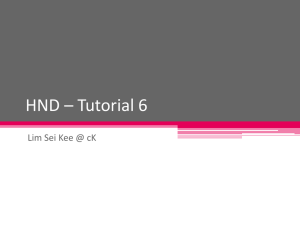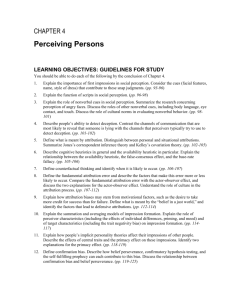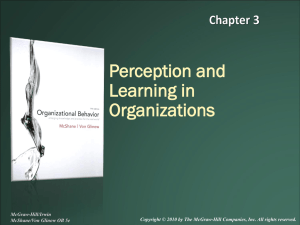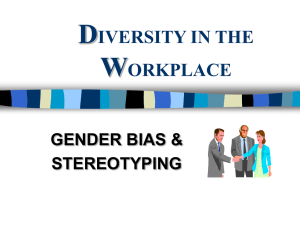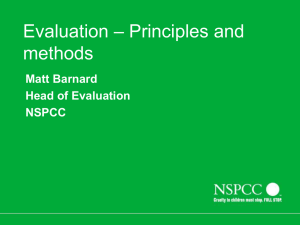HNDBM * 6. MCQ - WordPress.com
advertisement
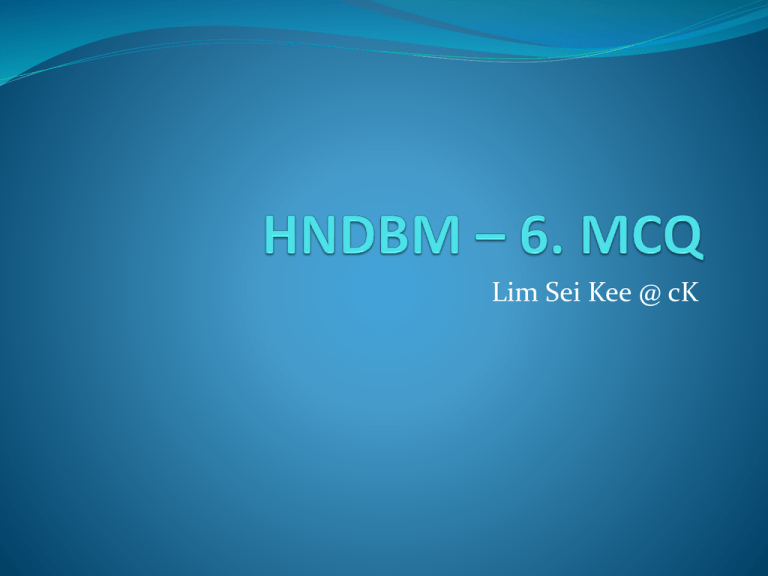
Lim Sei Kee @ cK 1) Two people see the same thing at the same time yet interpret it differently. Where do the factors that operate to shape their dissimilar perceptions reside? A) the perceivers B) the target C) the timing D) the context E) the situation 2) What are the three classes of factors that influence perception? A) factors in the setting, factors in the environment and factors in the motives B) factors in the perceiver, factors in the target and factors in the situation C) factors in the character, factors in knowledge and factors in experience D) factors in the personality, factors in the character and factors in the values E) factors in the senses, factors in the surroundings and factors in the lighting 3) David has the opinion that people who drive SUVs are dangerous drivers. He often perceives that people driving SUVs are doing so in a dangerous manner, even when other observers can see nothing wrong with the behavior of the SUV drivers. What factor in David is affecting his perception in this case? A) his interests B) his experiences C) his expectations D) his motives E) his background 4) What is the theory that suggests that when we observe an individual's behavior, we attempt to determine whether it was internally or externally caused? A) Behavioral Theory B) Judgment Theory C) Selective Perception Theory D) Attribution Theory E) Equality Theory 5) What term is used for the extent to which an individual displays different behaviors in different situations? A) continuity B) integrity C) stability D) flexibility E) distinctiveness 6) If everyone who is faced with a similar situation responds in the same way, attribution theory states that the behavior shows ________. A) consensus B) similarity C) reliability D) consistency E) stability 7) What name is used for the tendency of an individual to attribute his own successes to internal factors while putting the blame for failures on external factors? A) the fundamental attribution error B) the self-serving bias C) consistency D) selective perception E) stereotyping 8) Allison has just presented her paper and has done an excellent job. Why should you not want to present your own paper directly after she does? A) to avoid the stereotyping effect B) to avoid the halo effect C) to avoid the contrast effect D) to avoid the projection effect E) to avoid the ultimate attribution error 9) You have heard that the teacher believes that men perform better in oral presentations than women. What shortcut has the teacher used in this case? A) the halo effect B) the contrast effect C) projection D) stereotyping E) prototyping 10) Why is decision making a perceptual issue? A) Decisions must be made on how to move from the current state of affairs to some desired state. B) Middle- and lower-level managers may have different perceptions on how to solve a problem than their underlings or top level managers. C) Decision making is generally by consensus. D) There may be more than one way to solve a problem. E) Before a decision is made, a problem must be perceived to exist. 11) Mel has exceeded her budget by at least $200 every month for the last three months. After recognizing that this is a problem, she decides to use the rational decision-making model to decide what to do. What might be the next step she takes if she follows this model? A) determining what she needs to take into account when making her decision B) choosing a method to cut her expenses C) weighing the relative importance of each of her expenses D) coming up with different ways that would either reduce her expenses or increase her income E) evaluating different ways that she could use to either reduce her expenses or increase her income 12) In the following steps in rational decision making, which would come first? A) Generate alternatives. B) Identify criteria. C) Make a choice. D) Implement the decision. E) Assess the outcome. 13) What is the unconscious process created out of distilled experience? A) rational problem-solving B) bounded rationality C) intuitive decision-making D) randomness E) creativity 14) Gene is regarded by his peers as an extremely creative designer of watercraft. He attributes much of his success to his family: he was raised by a traditional boat builder and from a very early age was surrounded by boats and the people who made them. To what element of the threecomponent model of creativity does Gene attribute his success? A) intuitiveness B) insight C) intrinsic task motivation D) expertise E) creative thinking skills 15) Whenever Jane is successful she takes full credit for what has happened, but whenever she is unsuccessful she attributes her failure to bad luck or blames one of her fellow employees. She is guilty of ________. A) the fundamental attribution error B) attribution bias C) the halo effect D) distinctiveness E) the self-serving bias TRUE or FALSE? 1. Perception refers to the way we organize and interpret the world around us. 2. Individuals involved in the same situation will usually perceive that situation similarly. 3. Attribution theory looks at the internal and external causes of behavior. 4. James is consistently late to work, is the source of regular complaints by his co-workers, and produces low quality work. His manager is most likely, then, to give the behavior an external attribution. 5. One person's problem may be considered by another person to be a satisfactory state of affairs. 6. All rational decision makers can be expected to identify and select the same problems to solve. 7. Intuition occurs outside conscious thought and usually engages emotions. 8. Most people do not have creative potential. 9. It has been well documented that individuals escalate commitment to a failing course of action when they view themselves as responsible for the failure. 10. Most decisions in the business world follow the rational model. 1) What is the relationship between what one perceives and objective reality? A) They are the same. B) They can be substantially different. C) They should be the same. D) They are rarely if ever the same. E) They cannot be the same. 2) If a manager attributes an employee's reasons for being late to internally caused behaviors, the manager A) would see the the employee as having been forced into being late by the situation. B) might attribute the employee's lateness to construction that tied up traffic on the road this employee regularly travels. C) might attribute the employee's lateness to partying the night before and then oversleeping. D) might attribute the lateness to outside causes. E) all of the above. 3) Janice is late for work each day by about ten minutes. How would attribution theory describe this behavior? A) It shows consensus and is attributed to internal causes. B) It shows similarity and is attributed to external causes. C) It shows reliability and is attributed to external causes. D) It shows consistency and is attributed to internal causes. E) It shows distinctiveness and is attributed to internal causes. 4) Shortcuts in judging others include all of the following except ________. A) stereotyping B) halo effect C) selective perception D) self-serving bias E) contrast effects 5) What is the term used for drawing a general impression about an individual based on a single characteristic such as intelligence, sociability, or appearance? A) the contrast effect B) personal bias C) prejudice D) the halo effect E) projection 6) Which of the following statements is not an example of stereotyping? A) There is no need to offer child-care to him; men aren't interested in child care. B) Don't hire an older worker; they can't learn new skills. C) She was good at her last job, so she will be good at this one. D) She won't relocate for a promotion, since women don't relocate. E) The new hire will be emotionally insensitive, since he is a man. 7) Which of the following is an assumption of the rational decision-making model? A) The decision maker has unlimited time to make the decision. B) The decision criteria are flexible. C) The decision maker can identify all the relevant criteria in an unbiased way. D) The decision maker is aware of all the possible consequences of each alternative. E) The decision maker does not have complete information. 8) What do we call the tendency for people to base their judgments on information that they can easily obtain? A) representative bias B) availability bias C) confirmation bias D) anchoring bias E) principality 9) When one "throws good money after bad," which judgment bias is present? A) escalation of commitment B) hindsight C) satisficing D) representative E) rose-colored glasses 10) You are the manager of a development group in a large computer software company. You have decided that it is important for your group to understand the many ways that ethical decisions can be made and you are designing a training program on the subject of ethics. You want to teach the decision criterion that currently dominates business decision-making. Which decision criterion will you teach? A) utilitarian B) justice C) rights D) privilege E) assertion 11) What trait does a decision maker need to have if they are to fully appraise a problem and even see problems that others are not aware of? A) creativity B) rationality C) conceptual style D) intuition E) individuality 12) What should Susan avoid doing if she is to encourage creativity in her committee? A) encourage the flow of ideas B) judge ideas fairly and constructively C) sharply define the problem to be solved D) give rewards and recognition for creative work E) support the committee 13) If Joseph wants to be more creative, research suggests that he should A) do things that make him happy. B) listen to music he enjoys. C) socialize with others. D) all of the above. 14) What is the segment in the three-component model of creativity that turns creative potential into actual creative ideas? A) expertise B) creative thinking skills C) intrinsic task motivation D) intuition E) realization 15) What trait does a decision maker need to have if they are to fully appraise a problem and even see problems that others are not aware of? A) creativity B) rationality C) conceptual style D) intuition E) individuality Brainstorming Group activity: Your group assumes the role of a team of BMW workers who are told to formulate some sensible suggestions for cutting costs in the divisions of the company that produce vehicles. Top management informs you that it costs BMW about $2000 more to produce a vehicle than it does its Asian competitors. You are also told, “Use your creative thinking to the best of your abilities. The survival of BMW as a vehicle producer is at stake.” Present your findings in a bulleted list to the rest of the class. Individual Assignment 1. 2. 3. 4. 5. Define perception. What is attribution theory? What are its implications for explaining organizational behavior? How are our perceptions of out own actions different from our perceptions of the actions of others? How does selectivity affect perception? Give an example of how selectivity can create perceptual distortion. What is the rational decision-making model? Under what conditions is it applicable?
